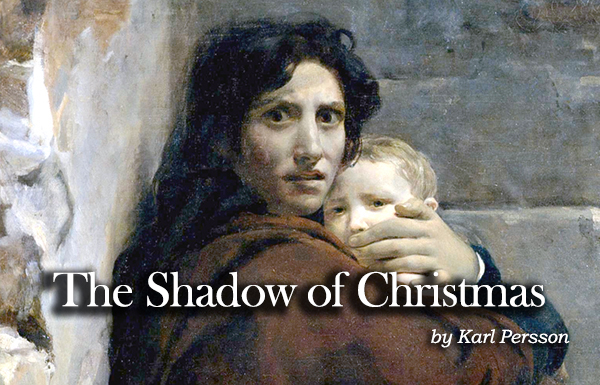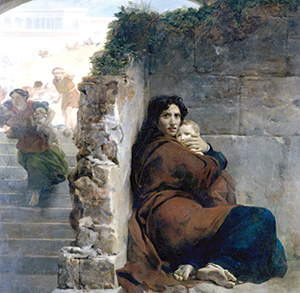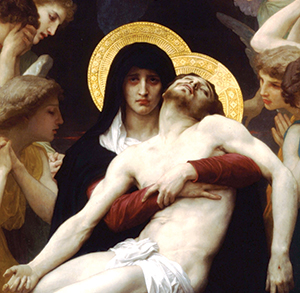The Shadow of Christmas

by Karl Persson
“They said there’ll be snow at Christmas. They said there’ll be peace on Earth. But instead it just kept on raining. A veil of tears for the virgin birth.”
So sings Greg Lake, disaffected by Christmas—and he is not alone. Perhaps it is because it is a season so touched by light that we are also more aware of the depth of the darkness around us—“the people who walked in darkness have indeed seen a great light” (Isaiah 9:2), but that makes the darkness that remains around us that much more unbearable by contrast.
Even the secular world can sense it. Even left with the paper-thin shadow of an absent faith marked by the dregs of a secular season, the world can still see, if not the hope of Christmas, at least the truth that there is something to be disappointed about. Greg Lake’s song may not be particularly good, but it is a cry of pain emerging from a long lineage of Christmas mourning, whether sacred or secular, kitschy or profound. Dickens saw ghosts, Elvis had a blue Christmas, and we all have our Grinchy moments. Even behind some of our more apparently heartwarming traditions there is sometimes a darker, more serious edge. When we recall the hearty “Good King Wenceslaus,” we often forget that he was eventually martyred for trying to be a good Christian ruler.
But speaking of martyrs, what of Christianity? What does Christianity have to say about sadness at Christmas? Must it say what so many would have it say, that if we would only rediscover the “true meaning” of Christmas the darkness would just go away? That all we need is to put the Christ back in Christmas?
What does Christianity have to say about sadness at Christmas? Must it say what so many would have it say, that if we would only rediscover the “true meaning” of Christmas the darkness would just go away? That all we need is to put the Christ back in Christmas?
Fortunately our faith is wider and our forebears in the faith wiser than this. And it is on this wisdom I would like us to meditate for a moment, as we work backward from our present faith, through the wisdom passed on to us through the Church calendar, and finally back to Scripture itself.
The Meaning of Advent
Let us first of all not underestimate the Church calendar. It is not, to be sure, Scripture, but it is a composite of Scripture-inflected wisdom passed on to us, to help us remember the right things at the right times, and to draw us into the redemption of time itself. And what we find when we look to the Church calendar is that the ostensible innovation of a hard, realistic, disenchanted perspective on Christmas is not in fact a modern innovation—before the world got there, the Church got there first. Before modernity, there was Advent, and it was good.
It was good because it was sober. The typical Christmas response to the kind of disappointment we see in Lake’s lyrics is to get drunk so we can forget about the whole thing. It’s certainly a film cliché; we all remember Mel Gibson in Lethal Weapon. But Christianity is more daring, and insists we remain sober while looking darkness in the face. Traditionally, this is what Advent is—a time of fasting and asceticism and looking reality in the face.
A church I once attended was preaching Advent sermons on “the four last things”: death, judgment, heaven, and hell. The promotional poster for the series featured a large skull, staring out at me like Yorick in Hamlet. This is entirely consistent with the Christian tradition, which celebrated Advent as a time of preparation for Christ’s coming; the season of Advent awaiting His first coming also points toward His second coming, for which Christians are to be prepared. To be sure, this is somewhat different from mere sadness, but if all sadness is understood as a type and shadow of the sadness of Adam under sin, it opens a theological way for thinking about the sadness some feel at Christmas.
Like Lambs to the Slaughter
But let us proceed to the narrative itself. The elements are familiar enough. A child is born in Bethlehem, and his parents know he is born for something special: he will grow up to serve the Lord, YHWH, the God who was there at the Exodus. And then something happens. There is a knock at the door. It’s a soldier sent from King Herod, who has become obsessed about rumors of some rival toddler king in Bethlehem and its vicinity. These parents know the story of Moses, how against all odds he was kept safe in a basket from the infanticidal Pharaoh. But theirs is not the story of Moses. There is not even time for shock. The soldiers kill the child, do their duty, and move on. And every year, against the backdrop of this story, we blissfully sing, “To us a Child is born/to us a Son is given.”
Because, of course, this child—the one who was killed—is not the One we are singing about. The Child we are thinking of has been safely transported to Egypt, His parents having been warned in a dream of Herod’s plot. But back in Bethlehem, countless other sons—helpless children—are dead.

This child—the one who was killed—is not the One we are singing about. The Child we are thinking of has been safely transported to Egypt, His parents having been warned in a dream of Herod’s plot. But back in Bethlehem, countless other sons—helpless children—are dead.
And we wonder, how can this be good news? How can we sing that song? Is our faith no more than a clash of kings, where we celebrate how the Chosen One—the Messiah—escaped, with little thought for the innocent victims caught in between? Is the kingdom of God just another “game of thrones”? What kind of faith can be perverse enough to have such a story as its backdrop? What kind of miracle would it take to redeem such a story? The angels appear to the shepherds, singing, “Glory to God in the highest, and on earth peace, good will toward men.” Can we, in good conscience, sing with them?
There is a cry, and that cry is recognized in Scripture. The cry is Rachel, weeping for her children, and refusing to be comforted because they are no more (Jeremiah 31:15, Matthew 2:18). In her cry is taken up a cry echoed throughout Scripture, a cry for lost sons and daughters. It is the cry of Job for his children. It is the cry of David for his lost sons—the one who rebelled, the one who died in infancy, and the one who turned to idolatry. It is the obscure and often-overlooked cry of Rizpah when her sons are handed over to the Gibeonites. It is the crying of Jairus for his daughter, and, yes, the tears of Abraham as he raises his knife to slay his son, his flesh and blood, on the altar. It is the weeping of Eve for Abel. It is YHWH weeping for His child, Israel; it is the Creator weeping over Adam. God Himself is weeping—can there be comfort for Rachel?
But there is more to the story, because the narrative takes an unexpected turn. The Messiah, Christ, does not grow up to become a force equal and opposite to the Herods, Pilates, and Caesars—rulers who build kingdoms to hide the blood of their many innocent victims. Jesus’ protection in Egypt is not simply an act of nepotism for a favorite son. No, He is protected in Egypt because the suffering reserved for him is greater. The weeping of Rachel must be answered, and He will answer with His blood.
The tender moments with His mother at the manger will eventually turn to that excruciating moment when He turns to her, shamed, naked, and contorted, and says to the beloved John—and to us also—“Behold your mother.” And we do. We look and find, here at the heart of history, Jesus’ mother, aching with the pain of a sword-pierced soul. And Rachel continues to weep. And Mary weeps, because the Child she treasured in her heart is no more. Or so it seems. For in her Son, death—the thing that we, with Rachel, weep over—is overcome.

We look and find, here at the heart of history, Jesus’ mother, aching with the pain of a sword-pierced soul. And Rachel continues to weep. And Mary weeps, because the Child she treasured in her heart is no more. Or so it seems. For in her Son, death—the thing that we, with Rachel, weep over—is overcome.
We Believe in the Resurrection…
And indeed, how could Rachel be answered otherwise? What mother would be satisfied with anything less than the unworking of her child’s death? Rachel refuses to be comforted, because comfort is not what she wants. She does not want comfort; she wants her children.
There is a wise rabbinic tradition that suggests that Job’s children are not doubled like the rest of his possessions at the end of the book bearing his name because children are not possessions. You can’t pay off the death of children simply by giving someone double the amount of children. As a solution, the rabbinic tradition suggests Job’s children were literally resurrected, but there is another possibility. Job is only given seven more sons and three daughters at the end of his calamities because God has in fact doubled his children, but in an unexpected way: half of them are not with him in this world; they are awaiting the resurrection of the dead and the life of the world to come.
And we, with Job, wait—still with the tears of Rachel—for the time at the end of the eschaton when every tear will be wiped away. That time is not yet, and so there are still tears. There are tears, and it is Christmas. But this—this hope—is why we can sing. Not because there is no suffering, not because there is no Rachel, not because there are no slaughtered innocents, whose blood indeed cries out in their feast during the season of Christmas. No, it is not because these things are not, but because He—Christ—is.
He is the Lamb slain from the foundation of the world (Revelation 13:8), who draws our weeping into Himself—into His body—till He is trembling and bent and dead from it. And we see Him trembling and convulsing, and know the end is near—until we look up at Him, exalted above the end of ages, and realize that He has done what is impossible, even more impossible than the alchemist’s trick of turning lead into gold.
He is shaking, but it is no longer with mourning—He has turned mourning into laughter, and death into life. But not yet—at least not for those of us still in the world of fallen history. For now we wait, continuing to weep for pain and sing for joy, until we discover behind them the deepest ground of both, which is our common yearning for Christ.
Amen, Come Lord Jesus.
———————
Dr. Karl Persson is a scholar and writer living in Winnipeg. His work focuses on the reception of biblical wisdom literature in the Patristic and Old English periods. (Banner and first inset image from Léon Cogniet’s 1824 painting “Massacre of the Innocents.” Second inset a detail from William-Adolphe Bouguereau’s 2876 “Pietà.”)
This article appears in the November/December 2014 issue of The Canadian Lutheran, which you can read online below:





